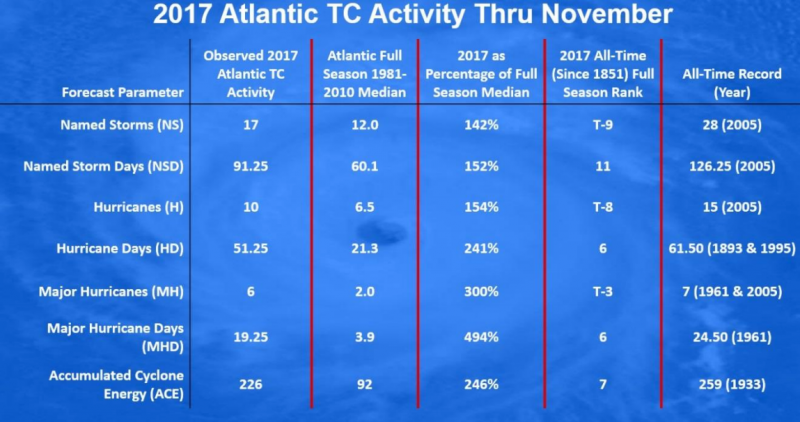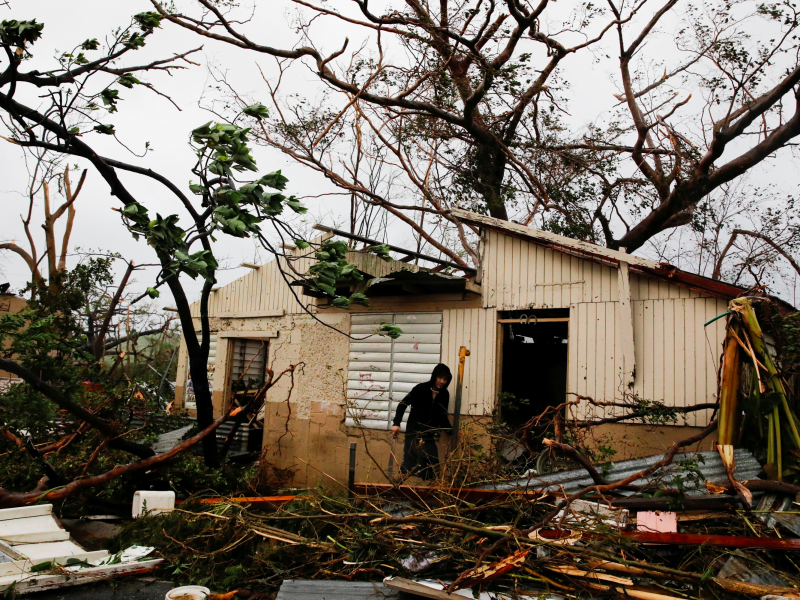The end of November marks the official end of Atlantic hurricane season – 97% of tropical cyclone activity occurs in the six-month between June and November.
That’s a relief after an intense few months of destructive storms. The 2017 Atlantic hurricane season was a top-10 hurricane season by most metrics. It set a few all-time records as well.
The chart below shows how 2017 stacks up to other years, thanks to data collected by meteorologists at Colorado State University’s Tropical Meteorology Project.

The season was "extremely active", to use the National Hurricane Center's technical term. In an "extremely active" year, storms have to generate at least 152.5 units of accumulated cyclone energy - a measure of storm intensity, duration, and frequency. 2017 hit 226, mostly due to storms in August and September, when Harvey, Irma, and Maria devastated parts of the Caribbean and US.
An "extremely active" season also has to meet two out of these three conditions: 13 or more named storms, seven or more hurricanes, and three or more major hurricanes. We hit all three, with 17 named storms, 10 hurricanes, and six major hurricanes.

Here are some of the all-time records set this year, according to CSU:
- September broke all-time records for the number of storm days, hurricane days, and major hurricane days. There were 40.25 hurricane days, since the days of each storm are counted separately.
- September 8 set the one-day record for accumulated cyclone energy (ACE), thanks the combined forces of Hurricanes Irma, Jose, and Katia. September also broke the record for most ACE in a month.
- Irma's maximum sustained wind speed of 185 mph made it the strongest storm that's ever existed in the Atlantic, outside the Caribbean and Gulf of Mexico. (Including those regions, it's the second strongest after Allen, which reached 190 mph).
- Irma set a record for maintaining that same intensity for 37 hours, longer than any other storm on the globe.
- Harvey broke the record for most rainfall from a tropical cyclone in the US, with more than 60 inches of rain falling at two measuring stations in Southeast Texas.
- This was the first known year that two Category 4 storms made landfall in the continental US: Irma and Harvey.
- Maria was the first Category 5 storm to hit Dominica and the strongest storm to hit Puerto Rico since 1928.
Overall, it was a rough year - one that exceeded forecasters' expectations, even though most called for an above-average season. The exact factors that made it so active are still under investigation, though warmer-than-normal sea surface temperatures likely played a role, since that allows storms to pick up intensity. A lack of strong wind shear, which can break apart storms, is considered a factor.
Hurricanes can still happen after November ends, however. As the National Oceanic and Atmospheric Administration notes, "there is nothing magical in these dates."
